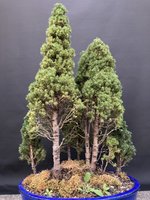Cruiser
Omono
Does anyone have any tips, feedback, or advice on how to proceed with this project?
4/29:
Planted 7 spruce in an 18”x15” seed tray. Approximately 1/3 of the root mass was removed. Used EB stone bonsai and cactus soil. Trees were wired into the tray before branch wiring/pruning to get an idea for the layout. (I realize this may have been a mistake).
The grouping looked alright but was missing variability so I added two more spruce that were previously worked on, a larger tree and a smaller one that were wired back in March. They were my first, so the wiring is pretty jenky. The total is now 9 trees.
I focused on having smaller trees and openness in front, placed the largest tree in the middle of the pot, and so far have kept a lower canopy in the rear. Spacing is somewhat uniform since I didn’t want to cut off too much root mass. Distribution is staggered with a more open understory to the right front of the pot. I plan to leave spike knots and forked tops for realism and possible jins later on.
To help reduce soil erosion I added some local moss. This was the easy part. It was growing 10 ft away on some concrete.
My next tentative step is to thin out the branches and wire to create a more mature looking canopy.
Please advise.
4/29:
Planted 7 spruce in an 18”x15” seed tray. Approximately 1/3 of the root mass was removed. Used EB stone bonsai and cactus soil. Trees were wired into the tray before branch wiring/pruning to get an idea for the layout. (I realize this may have been a mistake).
The grouping looked alright but was missing variability so I added two more spruce that were previously worked on, a larger tree and a smaller one that were wired back in March. They were my first, so the wiring is pretty jenky. The total is now 9 trees.
I focused on having smaller trees and openness in front, placed the largest tree in the middle of the pot, and so far have kept a lower canopy in the rear. Spacing is somewhat uniform since I didn’t want to cut off too much root mass. Distribution is staggered with a more open understory to the right front of the pot. I plan to leave spike knots and forked tops for realism and possible jins later on.
To help reduce soil erosion I added some local moss. This was the easy part. It was growing 10 ft away on some concrete.
My next tentative step is to thin out the branches and wire to create a more mature looking canopy.
Please advise.
Attachments
-
 25BA1174-4DD3-4A0B-BD73-516E06CA70EF.jpeg291.7 KB · Views: 246
25BA1174-4DD3-4A0B-BD73-516E06CA70EF.jpeg291.7 KB · Views: 246 -
 5A50F00D-8603-49E4-9533-4E3E7300E28E.jpeg307.9 KB · Views: 205
5A50F00D-8603-49E4-9533-4E3E7300E28E.jpeg307.9 KB · Views: 205 -
 C6D3EE71-51E3-4520-A5BF-DF1C0DAC1419.jpeg430.6 KB · Views: 185
C6D3EE71-51E3-4520-A5BF-DF1C0DAC1419.jpeg430.6 KB · Views: 185 -
 93EBE0DB-C9C5-4F08-9425-F90DE86E2A5F.jpeg350.2 KB · Views: 171
93EBE0DB-C9C5-4F08-9425-F90DE86E2A5F.jpeg350.2 KB · Views: 171 -
 4BD94C88-7A36-4CC9-A68A-39B4B61B9C7E.jpeg380.1 KB · Views: 166
4BD94C88-7A36-4CC9-A68A-39B4B61B9C7E.jpeg380.1 KB · Views: 166 -
 5B9C8C78-94DF-429A-A805-766931E80C54.jpeg277 KB · Views: 164
5B9C8C78-94DF-429A-A805-766931E80C54.jpeg277 KB · Views: 164 -
 E963F77F-F5C3-46F6-A572-7267E3463A43.jpeg306.9 KB · Views: 177
E963F77F-F5C3-46F6-A572-7267E3463A43.jpeg306.9 KB · Views: 177 -
 A9C715BB-57B2-48B8-BB64-B79B45511139.jpeg293.5 KB · Views: 229
A9C715BB-57B2-48B8-BB64-B79B45511139.jpeg293.5 KB · Views: 229







